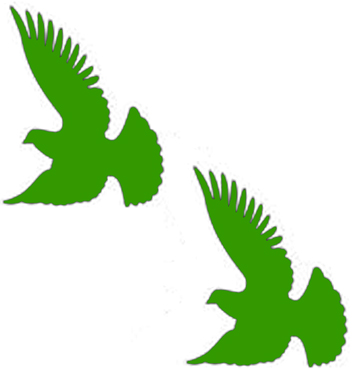Q: Lately I've had several people ask me in different ways about youngsters growing one or both deformed legs out to the side. The latest person asking me this question stated that his best pair of pigeons raised a youngster with the leg out to the side last year and then again this year. Is there something genetically wrong with his pair of pigeons?
The answer is definitely "no". There is no genetic flaw here. This is strictly a mechanical problem. When you have a youngster with a leg or legs that seem to slide out to the side (spread eagle), it usually occurs shortly after you band the youngster, and it is normally a single youngster in the nest.
So how do we avoid this kind of problem at Hackemer Lofts? First of all, you want your pigeons to have a nest with good bedding. Many of us have turned to using nest pads lately. This is a good option for early breeding and certainly gives the youngsters warmth and a good footing. But it is also a very artificial and sterile (boring) way for pigeons to nest.
I prefer a method somewhat different. I use the deep large clay nestbowls, the kind that are now sold with 4 little holes in the bottom. The first thing we do is tape the holes shut with a piece of duct tape. We then put about an inch of oil dry in the bottom of the nest bowl. Buy the cheapest kind available. This is not treated with any chemicals and is somewhat dusty.
We then give our birds straw in the feeders periodically. They are truly elated if they have not been given any straw for a couple of days and they will be very happy, carrying the straw to their nests and filling their nest bowl with it. Now I believe this carrying of the straw and building the nest helps cement the bond to their nest and home and makes for a happier bird who is not bored. The oil dry of course gives them a nice soft base that keeps the nest dry and insulates it somewhat from the cold.
It is important that if at all possible, you have 2 youngsters per nest. The splaying of the legs only occurs when there is a single youngster in the nest or you have no nesting material. So once you have banded your youngsters, try to combine them and free up your best pairs to go back for a new round. Don't be afraid to take your newly banded youngsters and put them all in a pile and match them by size so if at all possible each nest has 2 youngsters that are matched in size. If you end up with a single youngster, then be sure that you keep a dummy egg with it. In this way again you will eliminate or at least greatly minimize the chances of a youngster growing a leg out to the side.
So the formula is quite simple -- 2 youngsters in the nest or -- a youngster and an egg -- and good nesting material. Then your problem should be solved.
It is also a good idea to always clean the nest bowls between rounds and soak them in a laundry soap and bleach hot water solution to eliminate any kind of germs from one round to the next.
